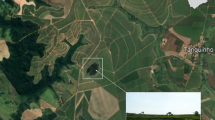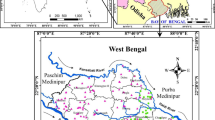Abstract
The determination of the redox potential (Eh) of underground water in repository site is extremely important for long-term safety evaluation. The present study has developed a novel methodology for Eh estimation of the underground water of Beishan borehole 28 (BS28), which consists of the on site logging, the modelling with the characteristics of sampled water and rock cores and the verification study dedicated to evaluate the reliability of the Eh measurement. An Eh range between − 56 and 118 mV is suggested for BS28 underground water at 365–690 m deep after a thorough analysis of both modelling data and measurements.






Similar content being viewed by others
References
Wang J (2010) High-level radioactive waste disposal in China: update 2010. J Rock Mech Geotech Eng 2:1–11
Wang J (2014) On area-specific underground research laboratory for geological disposal of high-level radioactive waste in China. J Rock Mech Geotech Eng 6(2):99–104
Wang J, Chen L, Su R, Zhao X (2018) The Beishan underground research laboratory for geological disposal of high-level radioactive waste in China: planning, site selection, site characterization and in situ tests. J Rock Mech Geotech Eng 10(3):411–435
Wu X, Kang M, Cai Z, Song Y, Shang C, Xu F, Wang J, Li Y, Chen F (2017) Investigation of redox potential of beishan site and its impact on mobility of redox-sensitive radionuclides. J Nucl Radiochem 39(3):227–234
Ma B, Charlet L, Fernandez-martinez A, Kang M, Madé B (2019) A review of the retention mechanisms of redox-sensitive radionuclides in multi-barrier systems. Appl Geochem 100:414–431
Albrecht S, Zimmermann T, Grützmann R, Tzmann R, Scheller D, Saeger HD, Distler W (1999) Redox sensitive behavior of selenite in the presence of reactive oxygen species. Are there nonenzymatic direct reaction pathways. Med Klinik 94(Suppl 3):70–73
Kang M, Jiang M, Yang Z, Chen F, Liu C (2013) Prediction of the species and solubility of uranium in beishan groundwater. J Nucl Radiochem 35(3):160–166
Kang M, Ma B, Bardelli F, Chen F, Liu C, Zhong Z, Wu S, Charlet L (2013) Interaction of aqueous Se(IV)/Se(VI) with FeSe/FeSe2: implication to Se redox process. J Hazard Mater 248–249:20–28
Kang M, Bardelli F, Charlet L, Géhin A, Shchukarev A, Chen F, Morel MC, Ma B, Liu C (2014) Redox reaction of aqueous selenite with As-rich pyrite from Jiguanshan ore mine (China): reaction products and pathway. Appl Geochem 47:130–140
Yang Z, Kang M, Ma B, Xie J, Chen F, Charlet L, Liu C (2014) Inhibition of U(VI) reduction by synthetic and natural pyrite. Environ Sci Technol 48(18):10716–10724
Çevirim-papaioannou N, Yal-ıntaş E, Gaona X, Dardenne K, Altmaier M, Geckeis H (2018) Redox chemistry of uranium in reducing, dilute to concentrated NaCl solutions. Appl Geochem 98:286–300
Stumm W, Morgan J (1970) Aquatic chemistry: chemical equilibria and rates in natural waters, 3rd edn. Wiley, Hoboken
Metz V, Kienzler B, Schussler W (2003) Geochemical evaluation of different groundwater—host rock systems for radioactive waste disposal. J Contam Hydrol 61(1–4):265–279
Auqué L, Gimeno MJ, Mez JG, Nilsson AC (2008) Potentiometrically measured Eh in groundwaters from the Scandinavian Shield. Appl Geochem 23(7):1820–1833
Nordstrom DK, Jenne EA, Ball JW (1979) Redox equilibria of iron in acid mine waters. In: Chemical modelling in aqueous system. ACS symposium series, Chapter 3, pp 51–79
Nordstrom DK, Puigdomenech I (1986) Redox chemistry of deep ground-waters in Sweden. SKB. Tech. Rep. http://www.skb.se/upload/publications/pdf/TR86-03webb.pdf. Accessed 25 May 2019
Grenthe I, Stumm W, Laaksuharju M, Nilsson AC, Wikberg P (1992) Redox potentials and redox reactions in deep groundwater systems. Chem Geol 98(s1–2):131–150
Guan H, Zhang Z, Su X, Long H, Wang B, Yao J, Song Z, Chen X (2009) Calculation on the distribution of americium species in Beishan groundwater. J Nucl Radiochem 31(2):121–124
Measuring ORP on YSI 6-series sondes: tips, cautions and limitations. YSI Environmental. https://www.ysi.com/File%20Library/Documents/Technical%20Notes/T608-Measuring-ORP-on-YSI-6-Series-Sondes-Tips-Cautions-and-Limitations.pdf. Accessed 25 May 2019
Office of water data coordination (1972) National handbook of recommended methods for water data acquisition. U.S.Geological Survey, Washington D.C.
Parkhurst DL, Appelo CAJ (1999) User’s guide to PHREEQC (Version 2): a computer program for speciation, one-dimensional transport, and inverse geochemical calculations. Water-resources investigation report. U.S.Geological Survey, Denver
Follin S, Stephens MB, Laaksoharju M, Nilsson AC, Smellie JAT, Tullborg EL (2008) Modelling the evolution of hydrochemical conditions in the Fennoscandian Shield during Holocene time using multidisciplinary information. Appl Geochem 23(7):2004–2020
Iwatsuki T, Yoshida H (1999) Groundwater chemistry and fracture mineralogy in the basement granitic rock in the Tono uranium mine area, Gifu prefecture, Japan—groundwater composition, Eh evolution analysis by fracture filling minerals. Geochem J 33(1):19–32
Japan Nuclear Cycle Development Institute (JNC). 2000. H12: Project to establish the scientific and technical basis for HLW disposal in Japan—Supporting Report 3, Safety assessment of the geological disposal system [R/OL]. JNC TN1410 2000-004. Japan Nuclear Cycle Development Institute, Ibaraki
Gascoyne M (2004) Hydrogeochemistry, groundwater ages and sources of salts in a granitic batholith on the Canadian shield, southeastern Manitoba. Appl Geochem 19(4):519–560
Fujimoto K, Ueda A, Ohtani T, Takahashi M, Ito H, Tanaka H, Bouiller AM (2007) Borehole water and hydrologic model around the nojima fault, SW Japan. Tectonophysics 443(3):174–182
Dou S, Chen F, Yang Y, Wu S, Kang M, Zhang R (2010) Estimation of saturation index for the precipitation of secondary minerals during waterrock interaction in granite terrains. Geochim 39(4):326–336
Brigatti MF, Caprilli E, Malferrari D, Mottana A (2007) Crystal structure and crystal chemistry of fluorannite and its relationships to annite. Miner Mag 71(6):683–690
Acknowledgements
Funding for this research was provided by the National Natural Science Foundation of China (NSFC, No. 41773095, 41403075) and the Fundamental Research Fund of Sun Yat-sen University No. 45000-18833403). The authors are grateful to Zhichao Zhou, Ming Zhang, Ruili Ji, Weiqiang Li and other workers from Beijing Research Institute of Uranium Geology, for their skilful and helpful contribution to the on site investigation. Thanks are also given to Prof. Gérard Cote (PSL Research University, Chimie ParisTech - CNRS, France), for his helpful and constructive comments. Declarations of interest: none.
Author information
Authors and Affiliations
Corresponding authors
Ethics declarations
Conflict of interest
The authors declare no conflict of interest.
Additional information
Publisher's Note
Springer Nature remains neutral with regard to jurisdictional claims in published maps and institutional affiliations.
Rights and permissions
About this article
Cite this article
Yang, G., Kang, M., Cheng, X. et al. A novel methodology for investigating the redox potential of underground water in China’s Beishan HLW repository site. J Radioanal Nucl Chem 322, 923–932 (2019). https://doi.org/10.1007/s10967-019-06728-x
Received:
Published:
Issue Date:
DOI: https://doi.org/10.1007/s10967-019-06728-x




